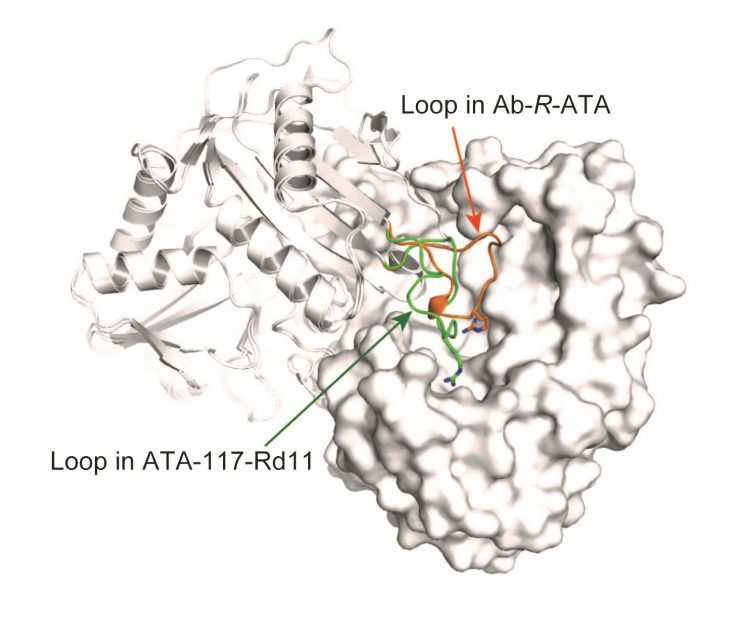How an important enzyme used in drug production recognizes its substrate

Comparison of loop conformation of Ab-R-ATA and artificially produced ATA-117-Rd11* © 2015 Masaru Tanokura.
A research group at the University of Tokyo has demonstrated the mechanism by which an enzyme used in industrial production of an important drug for type-2 diabetes recognizes its target. This finding will further design of novel biocatalysts for industrial production of chiral amine compounds, crucial building blocks in the synthesis of some pharmaceutical drugs.
Pure chiral amines are crucial building blocks in the synthesis of some pharmaceutical drugs, agrochemicals and other chemical compounds. Amine transaminases (ATAs) are the focus of increasing attention as useful tools for efficient chiral-amine production. In particular, R-stereospecific ATA (R-ATA), a type of ATA that produces only R-chiral amines, has great commercial value.
In 2010 two US pharmaceutical companies created a variant of an R-ATA allowing industrial-scale synthesis of sitagliptin, a medicine for type-2 diabetes. The improved enzyme gave a 53% increase in daily production volume and a 19% reduction in total cost, as compared to the chemical approach conventionally used to synthesize sitagliptin.
However, how the industrially-important enzyme R-ATA recognized its substrate and other details remained unclear.
The research group of Professor Masaru Tanokura at the Graduate School of Agricultural and Life Sciences of the University of Tokyo, in collaboration with Biotechnology and Development Laboratories of Kaneka Corporation, determined the crystal structures of R-ATA from a bacteria that lives in soil and other materials, Arthrobacter sp. KNK168 (Ab-R-RTA), and demonstrated the mechanism of the substrate recognition and substrate specificity of R-ATAs.
One unique characteristic of ATAs is that they recognize two different substrates in the same active site, and it was found that the active-site residue arginine (Arg138) functions on both substrates. Moreover, the structures of an artificial R-ATA and the G136F mutant of Ab-R-ATA (created by substituting the 136th base glycine for phenylalanine) revealed that a loop near the catalytic site was the target site that allowed the change in substrate specificity.
“These findings should lead to the rational design of R-ATAs based on this structural information to develop novel biocatalysts useful for the production of a diverse range of chiral amine compounds. This would accelerate the industrial uses of chiral-amine synthesis using R-ATAs,” says Professor Tanokura.
*Superimposed dimeric structures of Ab-R-ATA and ATA-117-Rd11. One protomer of the dimer is shown in surface representation (right) and the other is drawn as a ribbon diagram (left). The loops near the active sites of Ab-R-ATA and ATA-117-Rd11 are highlighted in orange and green, respectively, clearly showing the difference in structure.
Associated links
UTokyo Research article
Media Contact
All latest news from the category: Life Sciences and Chemistry
Articles and reports from the Life Sciences and chemistry area deal with applied and basic research into modern biology, chemistry and human medicine.
Valuable information can be found on a range of life sciences fields including bacteriology, biochemistry, bionics, bioinformatics, biophysics, biotechnology, genetics, geobotany, human biology, marine biology, microbiology, molecular biology, cellular biology, zoology, bioinorganic chemistry, microchemistry and environmental chemistry.
Newest articles

Properties of new materials for microchips
… can now be measured well. Reseachers of Delft University of Technology demonstrated measuring performance properties of ultrathin silicon membranes. Making ever smaller and more powerful chips requires new ultrathin…

Floating solar’s potential
… to support sustainable development by addressing climate, water, and energy goals holistically. A new study published this week in Nature Energy raises the potential for floating solar photovoltaics (FPV)…

Skyrmions move at record speeds
… a step towards the computing of the future. An international research team led by scientists from the CNRS1 has discovered that the magnetic nanobubbles2 known as skyrmions can be…





















